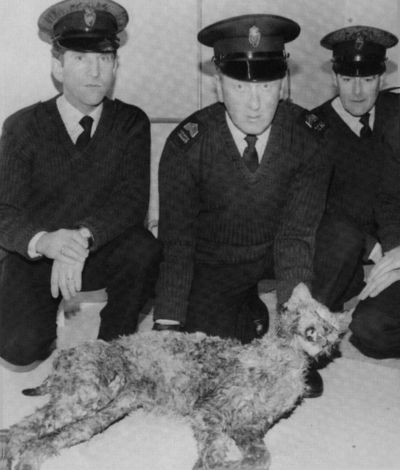
Report from Chris Smith
For comments on whether or not this is a caracal, see Photo Album

Meanwhile, In Northern Ireland
By Paul Sieveking in the Fortean Times 1996 ABC Roundup
On 15 February, a "lion cub" was seen twice in Fintona, Co. Tyrone, Northern Ireland. On 17 February, marksmen from the Royal Ulster Constabulary shot dead an African caracal lynx, prowling close to sheep in Fintona. It was wearing a black collar and was thought to be an escaped pet. It had been seen twice two days earlier, when it was thought to be a "lion cub". No local animal collector confessed to ownership. Hours later, police cornered and shot another animal, thought to be a domestic cat living in the wild in the same area. On 20 February, the "Beast of Ballymeana" was sighted in Kells, Co. Antrim. Inquiries uncovered two other recent sightings. A week later, the sightings were thought to be of a large domestic cat called Dylan.
Surprisingly, the Dangerous Wild Animals Act of 1976 does not apply in Northern Ireland. In theory, anyone in the province can keep a tiger in their back garden. In October 1995, an Arctic wolf escaped from its owner in Lisnaskea, Co. Fermanagh, and was shot dead eight days later.
Power Pets - The New Love Of Ireland.
By Mark Rowe in the Independent on Sunday 29 th June 1997
There may be no snakes in Ireland but there are big cats galore. Tigers, pumas and jaguars are fast becoming status pets in the north and the south. Ray Cimino, of the Dublin-based Trust for the Welfare of Captive Wildlife, said: "It is a growing problem. During the past five years the number of people owning tigers and other big cats has multiplied several times. It is not unusual to see them being taken for walks down country lanes. The RUC has had complaints that tiger cubs on leads have been taken into shopping centres."
The reason for the ownership of exotic pets - bears too have been found by officials - is that the 1976 Dangerous Wild Animals Act does not apply in Northern Ireland and no similar legislation exists in the Republic.
Angi Carroll, deputy director of the Dublin Society for the Prevention of Cruelty to Animals, said: "in Ireland you must have a licence for a dog but there's nothing to stop you walking down the high street with a tiger or a rhino. Most pets are sold in Belfast so people can drive up from Dublin and back across the border with a tiger cub within four hours. There is nothing furtive about it."
Ms Carroll and her colleagues can act on reports of wild animals being kept as domestic pets only if they believe the creatures are housed in poor conditions. Then they can prosecute under the 1911 Protection of Animals Act.
Last year, police on a routine drugs raid in a Dublin suburb found an adult jaguar and a serval (a wild cat) in a garage. In another incident at a Limerick farm, an ex-circus bear, two Siberian tigers, two tiger cubs and a baboon were found. The owner was prosecuted and banned for life from owning animals.
In the North, the RUC shot dead an African lynx which had been prowling close to sheep in Fintona, Co Tyrone. It was wearing a black collar and was thought tobe an escaped pet. Another alert was sparked by a stray wolf in Co Fermanagh. "Some people own them because they have a genuine interest in wildlife with a macho tinge," said Mr Cimino. "They are also popular with drug dealers as status symbols."
Many of the animals are sold by unscrupulous zoos or by travelling circuses. Others are bred in captivity. A tiger cub can be bought for as little as £ 150 and sold for £2,000.
However, many of the cubs do not survive into adulthood. "People think if they hand-rear a cub it will grow into a well-trained adult, but these cubs are taken off their mothers at a very early stage and often die by the age of five months because they haven't had the right nutrition," Mr Cimino said. 'People have no knowledge of how to raise them. They are not prepared to spend £ 25,000 on a proper secure habitat and so put them in garages or small cages in back gardens.'
Ms Carroll said: "At the moment these creatures are freely advertised in Dublin newspapers. We urgently need a change in the law but I suspect nothing will be done until somebody gets mauled."
The Royal Ulster Constabulary's wildlife liaison officer, Inspector Mark Mason, believes that an Act should be introduced to control the ownership of wild cats, but he also wants any such pet to have a microchip inserted in its neck to make it easily traceable.
The Independent On Sunday, 29 th June 1997
Report from Peter Dignan
We're grateful to Peter Dignan for the following - it looks like the P&J got the animal's species correct, but not the continent. Chris Smith
Lynx shot
From the Press and Journal 19 th February 1996
A WILD African Lynx roaming the countryside in Northern Ireland was shot dead in a field yesterday by police marksmen.
There had been sightings for days of what police believed was a young lion in the Fintona area of County Tyrone.
The lynx is thought to have escaped from a collector.
Press and Journal, 19 th February 1996
 |
 |
 |
| Return to index | Return to Scottish Big Cats | Return to Escapes & Captures |